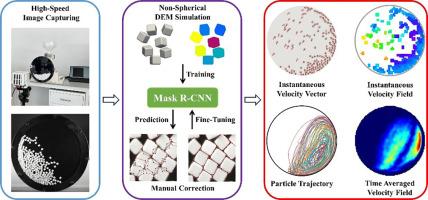An efficient non-spherical particle tracking strategy based on deep-learning and simulation-experiment integration
IF 4.6
2区 工程技术
Q2 ENGINEERING, CHEMICAL
引用次数: 0
Abstract
Image-based particle recognition and tracking are essential techniques for experimental investigations of granular systems. Conventional methods relying on geometric features are predominantly applied to spherical or near-spherical particle systems. The rapid development of machine-learning-based image segmentation methods has facilitated the identification of non-spherical particles. However, the laborious manual annotation required for model training limits their scalability or practical applicability. Moreover, these methods typically require substantial time and effort to rebuild algorithms or datasets when applied to particles of other shapes. To address these challenges, this study presents a novel non-spherical particle tracking strategy based on deep-learning and simulation-experiment integration. The Mask Region-based Convolutional Neural Network (Mask R-CNN) is pre-trained on the synthetic dataset generated using superquadric Discrete Element Method (DEM) simulation to establish initial detection capability. The model is subsequently fine-tuned using a small number of manually corrected experimental images to enhance the robustness against real-world noise such as inter-particle overlap and occlusion, insufficient resolution and illumination, and reflection artifacts. Finally, a Particle Tracking Velocimetry (PTV) method for non-spherical particles is developed based on masks predicted by the fine-tuned model. The AI-based PTV method is evaluated and validated in rotating drum experiments, demonstrating its adaptability and reliability across different particle shapes. The proposed strategy enables the rapid development of PTV methods for new non-spherical particles, providing a practical and generalizable solution for studying the flow behavior of non-spherical particles.

一种基于深度学习和仿真实验相结合的非球形粒子跟踪策略
基于图像的颗粒识别和跟踪是颗粒系统实验研究的基本技术。基于几何特征的传统方法主要应用于球形或近球形粒子系统。基于机器学习的图像分割方法的快速发展为非球形颗粒的识别提供了便利。然而,模型训练所需的费力的手工注释限制了它们的可伸缩性或实际适用性。此外,当应用于其他形状的粒子时,这些方法通常需要大量的时间和精力来重建算法或数据集。为了解决这些问题,本研究提出了一种基于深度学习和仿真实验相结合的非球形粒子跟踪策略。基于Mask区域的卷积神经网络(Mask R-CNN)在超二次离散元法(superquadric Discrete Element Method, DEM)模拟生成的合成数据集上进行预训练,建立初始检测能力。随后使用少量手动校正的实验图像对模型进行微调,以增强对现实世界噪声的鲁棒性,例如粒子间重叠和遮挡,分辨率和照明不足以及反射伪像。最后,提出了一种基于微调模型预测掩模的非球形粒子跟踪测速方法。在转鼓实验中对基于人工智能的PTV方法进行了评估和验证,证明了该方法对不同颗粒形状的适应性和可靠性。该策略使新型非球形颗粒的PTV方法得到快速发展,为研究非球形颗粒的流动行为提供了一个实用的、可推广的解决方案。
本文章由计算机程序翻译,如有差异,请以英文原文为准。
求助全文
约1分钟内获得全文
求助全文
来源期刊

Powder Technology
工程技术-工程:化工
CiteScore
9.90
自引率
15.40%
发文量
1047
审稿时长
46 days
期刊介绍:
Powder Technology is an International Journal on the Science and Technology of Wet and Dry Particulate Systems. Powder Technology publishes papers on all aspects of the formation of particles and their characterisation and on the study of systems containing particulate solids. No limitation is imposed on the size of the particles, which may range from nanometre scale, as in pigments or aerosols, to that of mined or quarried materials. The following list of topics is not intended to be comprehensive, but rather to indicate typical subjects which fall within the scope of the journal's interests:
Formation and synthesis of particles by precipitation and other methods.
Modification of particles by agglomeration, coating, comminution and attrition.
Characterisation of the size, shape, surface area, pore structure and strength of particles and agglomerates (including the origins and effects of inter particle forces).
Packing, failure, flow and permeability of assemblies of particles.
Particle-particle interactions and suspension rheology.
Handling and processing operations such as slurry flow, fluidization, pneumatic conveying.
Interactions between particles and their environment, including delivery of particulate products to the body.
Applications of particle technology in production of pharmaceuticals, chemicals, foods, pigments, structural, and functional materials and in environmental and energy related matters.
For materials-oriented contributions we are looking for articles revealing the effect of particle/powder characteristics (size, morphology and composition, in that order) on material performance or functionality and, ideally, comparison to any industrial standard.
 求助内容:
求助内容: 应助结果提醒方式:
应助结果提醒方式:


